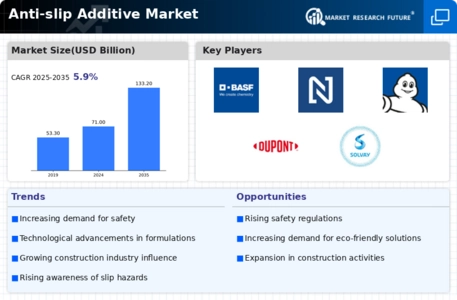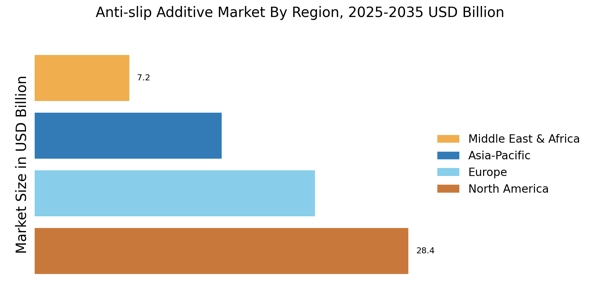Growing Awareness of Slip Hazards
There appears to be a growing awareness of slip hazards among consumers and businesses alike, which is driving the Anti-slip Additive Market. Educational campaigns and safety training programs have highlighted the risks associated with slippery surfaces, leading to a proactive approach in mitigating these hazards. As a result, more businesses are incorporating anti-slip additives into their flooring solutions to enhance safety and reduce liability. This trend is particularly pronounced in sectors such as retail and healthcare, where customer and employee safety is paramount. The increased focus on slip prevention is likely to sustain the demand for anti-slip additives, indicating a robust growth trajectory for the Anti-slip Additive Market.
Rising Demand for Safety Solutions
The increasing emphasis on safety in various industries appears to be a primary driver for the Anti-slip Additive Market. As organizations strive to minimize accidents and enhance workplace safety, the demand for anti-slip solutions is likely to rise. According to recent data, slips and falls account for a significant percentage of workplace injuries, prompting companies to invest in safety measures. This trend is particularly evident in sectors such as construction, manufacturing, and hospitality, where the risk of slips is heightened. The Anti-slip Additive Market is thus positioned to benefit from this growing awareness and regulatory pressure, as businesses seek to comply with safety standards and protect their workforce.
Regulatory Compliance and Standards
The increasing stringency of regulatory compliance and safety standards is a significant driver for the Anti-slip Additive Market. Governments and regulatory bodies are implementing stricter guidelines to ensure safety in public spaces, which necessitates the use of anti-slip solutions in various applications. Industries such as hospitality, healthcare, and transportation are particularly affected, as they must adhere to these regulations to avoid penalties and ensure the safety of their patrons and employees. This regulatory landscape is likely to propel the demand for anti-slip additives, as businesses seek to comply with safety standards and enhance their reputation. Consequently, the Anti-slip Additive Market is expected to thrive in this environment.
Expansion of Construction Activities
The ongoing expansion of construction activities across various regions is likely to bolster the Anti-slip Additive Market. With urbanization and infrastructure development on the rise, there is a heightened need for materials that ensure safety in public and private spaces. The construction sector has been a significant contributor to the demand for anti-slip additives, as these products are essential for flooring solutions in commercial buildings, residential complexes, and outdoor areas. Market data indicates that the construction industry is projected to grow steadily, which may lead to an increased uptake of anti-slip additives to enhance safety features in new developments. This trend suggests a promising outlook for the Anti-slip Additive Market.
Technological Innovations in Additive Formulations
Technological innovations in the formulation of anti-slip additives are poised to transform the Anti-slip Additive Market. Advances in material science have led to the development of more effective and durable additives that can be seamlessly integrated into various surfaces. These innovations not only enhance the performance of anti-slip solutions but also expand their applicability across different environments, including residential, commercial, and industrial settings. The introduction of eco-friendly formulations is also gaining traction, aligning with sustainability trends. As manufacturers continue to invest in research and development, the Anti-slip Additive Market is likely to experience a surge in product offerings, catering to diverse consumer needs.


















Leave a Comment